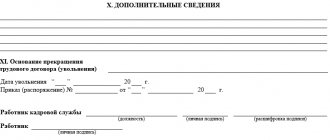What does the state say
Disabled people are one of the socially protected categories of the population. The state tries to support them as much as possible, therefore, in matters of dismissal, the Labor Code is quite loyal to them. It is possible to dismiss a disabled person at the initiative of the employer, but there must be very compelling reasons for this, which will be discussed below.
Legislative acts that regulate the employment and dismissal of people with disabilities:
- The Constitution of the Russian Federation - according to it, any person has the right to work according to his abilities, the area of which he has the right to choose independently;
- Labor Code - disabled people are subject to its requirements in the same way as other employees;
- Federal Law No. 181 “On the Protection of Persons with Disabilities.”
https://youtu.be/9rHaEgI1wnU
Papers are important!
In any of the listed cases, it is absolutely important to formalize the dismissal of a group 2 disabled person correctly. If the labor inspectorate comes, it is guaranteed to be interested in this sensitive issue and will double-check all the employer’s actions regarding an employee with disabilities. To protect yourself from fines and problems, you need to establish document flow in the HR department.
It must be said that employing disabled people from the very beginning is not an easy task, so many entrepreneurs try not to contact such workers at all. And in vain, because by doing so they deprive themselves of the opportunity to receive preferences and benefits from the state. The more people with disabilities are employed by the company, the greater the benefit. In general, benefits for disabled personnel are much less than the benefits that the government gives to the employer who provides these people with jobs.
Documents for the disabled person and the employer
When something happens to a person that affects his ability to work, the word is up to the doctors. While an employee is on sick leave, he is not subject to dismissal for any reason. But after recovery, the medical commission will make a conclusion about his state of health and future professional suitability. The employer will obtain this information from the medical documents that the employee must provide to him:
- medical report on granting a disability group;
- certificate of the degree of disability;
- a rehabilitation program designed taking into account the individual nature of the disability.
An individual rehabilitation program (IRP) contains working conditions that are not contraindicated for the employee in accordance with his new status, as well as the need for their duration, permanent or temporary (the period of time must be specified). It is the IPR that the employer should focus on when organizing work for a disabled employee, if there is no talk of dismissal.
IMPORTANT! If an employee who has received a disability decides to resign due to health reasons and does not want to advertise his condition to the employer, he is not required to present an IPR. This document will only be relevant if the employee remains at work, but on different conditions or in a different position. In a situation of dismissal, a medical certificate of unsuitability is sufficient.
Dismissal and disability
If, for some reason, it was decided to terminate the employment relationship with the employee (you must remember about job quotas for people with disabilities), it should be taken into account that dismissal is carried out approximately the same for all groups (1, 2, 3). The main thing is to follow the necessary procedure.
The easiest way to dismiss a group 2 disabled person is an action justified by a medical report. That is, doctors indicate in which positions, with which operations a person cannot work. If the current position falls under this list, the employment contract must be terminated. This is stated in Article 83 of the Labor Code. In addition to the requirements of the Labor Code, it is important to take into account Federal Law 181, dedicated to the rights of persons with disabilities in the Russian Federation. Among other issues, it also reveals the employment of people with disabilities and its features.
Disability group and employee status
Depending on the degree and time of disability, one or another disability group is assigned. Each group has its own requirements regarding dismissal.
1 group. Severe irreversible impairment of body functions, as a result of which a person completely loses the ability to work or retains the ability to perform certain activities that require significant assistance. Keeping such an employee at work is possible only if the nature of the illness allows the employer to provide the necessary conditions.
FOR EXAMPLE: if a person has lost or paralyzed their legs, if a person had a position that involved mental stress or computer work, he will be able to continue working if he has assistance in moving.
2nd group. Labor loss is a significant percentage. To recover, the employee will need a long time, longer than 4 months, and in order to work, he will need special devices or conditions that need to be specially created. However, a person with this disability group may remain at work (with changes in position or responsibilities) if the conditions comply with his IPR.
IMPORTANT INFORMATION! If employees of groups 1 and 2 continue to work, they are guaranteed preferential labor rights:
- working week reduced to 35 hours;
- the possibility of two months of administrative leave;
- 30 days annual leave (instead of 28 days);
- involvement in night and overtime work only with their consent (if health allows).
3rd group. Loss of health has little effect on work functions and/or can be compensated for up to 4 months. Work is possible with a reduction in standards or a slight reduction in load. Such employees are subject to almost general requirements of the Labor Code. Among the benefits, the only benefits provided for them are an increase in annual leave by 2 days and a ban on being involved in night and overtime work without their consent.
It is important!
It is important to remember that a reduction cannot be applied if the employee is a pregnant woman or raising a child less than three years old, as well as a single mother with a child under 14 years of age. Special conditions apply to those mothers raising disabled minor children. In addition, the scheme for selecting workers who remain at the enterprise during a staff reduction program is quite complex, forcing workers to be assessed according to a number of significant criteria. The main indicators here are indicators of qualifications, efficiency, productivity, but not health.
For disabled people, preferences for layoffs are possible only in one case - when these employees turned out to be the most highly qualified and productive. Then, among the best, the selection is made, first of all, paying attention to people with disabilities, as well as those who have children or acquired occupational diseases. There are several other categories that have an increased chance of holding on to a job during layoffs. A complete current list can be found in the federal laws of the Russian Federation and the Labor Code.
How to fire a disabled person (general provisions)
The usual procedure for dismissal for health reasons includes the following steps.
- Closing the certificate of incapacity for work.
- Providing documents on health status. If a medical report indicates a significant loss of ability to work, and local documents prove that the person will no longer be able to perform his functions, the employment relationship with the disabled person is terminated (Article 83 of the Labor Code of the Russian Federation).
- In other situations, after analyzing the IPR, the employer decides whether he can provide the disabled person with work in the conditions required for him.
- The employer offers the disabled person in writing other positions, work in which will not negatively affect his health. Depending on the IPR, the transfer offer may be temporary or permanent. Unfortunately, most often such positions involve a lower salary. The employee’s consent or disagreement to the transition must also be documented in writing.
- If there are no vacant positions suitable for a disabled person at the enterprise, or the employee does not agree to them, dismissal will follow under Article 77, Part 8 of the Labor Code of the Russian Federation (at the initiative of management).
IMPORTANT INFORMATION! If the disability is group 3, and the IPR contains information that it will take less than 4 months to recover, then if there are no vacant positions suitable for temporary transfer, the employer may not fire the employee, but suspend him from work until the circumstances change.
Violation of discipline
Not all managers know whether it is possible to fire a group 2 disabled person without his consent. Since he was hired on a general basis, the requirements of the law are not relaxed for this category of personnel. It is impossible to fire a person just because he was given group 2 disability. The main factor is a gross violation of legislation and labor activity:
- Absenteeism or absence from work without a valid reason.
- Repeated failure to fulfill assigned job duties.
- Being in the workplace while intoxicated or under the influence of psychotropic substances.
- Disclosure of the organization's trade secrets and employee data to competitors.
- Misconduct towards minors.
- Failure to act resulting in an accident or emergency.
- Fictitious documents about the presence of disability.
The employer must establish any of the facts, record and prove if necessary. Basically, acts and orders are drawn up about violations, with which the employee is familiarized. They subsequently serve as evidence when the dismissed person challenges the organization’s actions in court or the labor inspectorate. An employee is dismissed without work.
The reasons for dismissal do not always depend on the manager and the employee. For health reasons, disability group 2 can be assigned due to complete loss of ability to work.
The conclusion of the medical commission serves as the basis for dismissal due to disability of group 2. An order under an article of the Labor Code of the Russian Federation is drawn up only if the employee is clearly recognized as incompetent.
Other grounds for dismissal
If you close your eyes to the medical component, in other respects, from the point of view of the law, a disabled person is the same employee as everyone else. He can be fired for the same reasons as another employee, but there are some nuances related to the social protection of disabled people. Let's consider them in the context of dismissal clauses.
- At your own request . A disabled person can terminate cooperation of his own free will by writing a corresponding statement. The law allows him, as a benefit, not to work the required 14 days.
- Inadequacy for your position . If a disabled person fails to pass recertification with the required results, he has the right to be dismissed, like another insufficiently qualified employee. The employer may provide him with another position for which he meets the requirements, if such a vacancy exists and the employee agrees to it.
- Reduction in staff or numbers . Here there are several more opportunities for a disabled person to stay, because the law regulates their priority for such grounds for dismissal. With equal performance indicators, the employer is obliged to retain an employee with a disability or a guardian of a disabled relative, especially if the disability was the result of working for this employer. It is important to remember that the determining factor will not be the disability, but the employee’s skill level.
- Failure to comply with labor regulations . Like any employee, a disabled person must obey the Labor Code requirements regarding labor discipline. He can be fired for proven absenteeism, repeated tardiness, or other disciplinary violations in the usual manner.
- Agreement of the parties . A disabled person can negotiate with the employer about dismissal on mutually acceptable terms.
- Liquidation of an enterprise or change of owner . There’s nothing you can do about it; absolutely all employees, even preferential categories, fall under this basis.
ATTENTION! Registration of dismissal of a disabled person is carried out in accordance with the usual regulations of this procedure, depending on the article. The situation is similar with dismissal payments.
Dismissal procedure
An employee who has received a disability group can resign at any time at his own request or by agreement of the parties. If an enterprise is declared bankrupt and closed, all employees are subject to dismissal.
Many employers are wary of hiring people with disabilities and are afraid of the procedure for dismissing them. You can fire a disabled person of group 2 if he wants to work, but:
- The organization cannot provide him with the necessary working conditions.
- The employee does not agree with the transfer to a low-paid job.
- Does not comply with the requirements of the working day and work schedule.
In cases where an employee with a disability resigns of his own free will, the manager signs the application without hesitation. The employee writes an application, certifies it with a personal signature and coordinates it with management personnel.
The decision whether an employee should work for 2 weeks or dismiss him in one day is decided by the immediate supervisor.
The organization issues a dismissal order, which the employee is familiarized with against receipt. The order data is transferred to the work book, which is issued to the quitter along with the salary calculation. The recording is made in strict accordance with the order.
After receiving the results of a medical commission from the employee regarding disability, the manager has the right to suspend him from work for up to 4 months. During this time, the employer considers the possibility of providing a workplace that meets the requirements of the employee's health condition.
The employee is notified of a new position or the absence of a workplace that meets medical indications in writing. If the employee refuses the organization’s proposals, dismissal occurs at the initiative of the employer with payment of two weeks’ salary.
Life after dismissal
Dismissal due to disability is not a death sentence for further employment. A person whose ability to work is limited is supported by the state in his desire to work. For this purpose, he is provided with the following preferences:
- the opportunity to acquire a new profession at the expense of the budget;
- employment in certain positions specifically for disabled people according to the state quota;
- tax deductions;
- protection of the right to work (illegality of refusal to employ a suitable position due to health reasons).
An employee has become disabled: what to do?
This situation has already been briefly discussed above. Acquiring disabled status for an employee can be both a path to receiving preferences and a reason to lose a job if the employer considers that it does not have the ability to provide working conditions or a suitable position. In general, the situation is not as complicated as many people think, and the Federal Law and Labor Code provide detailed recommendations on what to do in such a case, avoiding violations of the laws.
As for the recommendations of specialists, the first thing HR professionals advise to do is to invite the employee to dialogue. The employer must ensure that the employee is interested in continuing to work. You need to understand that becoming disabled is a difficult life situation, and many people, finding themselves in it, behave unstable, indecisively, not yet fully realizing what they are faced with. Therefore, you need to be prepared for the fact that the decisions they make will change over time. But if during the interview the employee showed a firm intention to continue working, the further procedure can begin.
Termination of employment at one's own request
Dismissal of a disabled person at his own request is the most common option. An employee who expresses an intention to terminate the contract is dismissed on the general basis provided for by the Labor Code of the Russian Federation. In accordance with its norms, termination of the contract occurs according to the following rules:
- the employee writes a statement 14 days before the expected date of dismissal;
- the period of “working off” can be reduced by agreement of the parties;
- vacation or illness are not grounds for postponing the date of dismissal;
- on the last working day, the employer is obliged to pay the employee in full - pay him the last month’s salary, bonus (if applicable), compensation for unused vacation, severance pay (in cases stipulated by law);
- the dismissed person is given a work book, copies of orders concerning him (upon request), certificates in form 2-NDFL (on income) and 182-n (on social payments made).
Taxation issues
In accordance with Article 217 of the Tax Code of the Russian Federation, personal income tax is not withheld from severance pay.
However, this rule applies only to those cases where the amount of the benefit does not exceed three times the average earnings. It operates in all regions of the country, with the exception of the northern territories.
For regions of the Far North, severance pay in an amount less than 6 times the average salary is not subject to personal income tax.
Many people who have received conclusions about permanent disability want, can and continue to work and lead a fairly active lifestyle, sometimes much more interesting than physically healthy people.
The state takes care of citizens who, due to their state of health, are recognized as disabled people of groups 1-3, depending on the degree of disability.
Disabled people are paid pensions, certain benefits are provided for housing and utility bills, and other privileges.
The issue of employment of people with disabilities is also resolved at the legislative level.
According to the twenty-first article of the Federal Law “On Social Protection of Disabled Persons of the Russian Federation,” the employer is obliged to employ people with disabilities if the number of employees exceeds 100 people, according to a quota of two to four percent in relation to the average staff.
In addition, the law stipulates that, regardless of the form of ownership, disabled people must also be employed in enterprises that employ from 35 to 100 people.
A natural question arises: is it possible to fire a disabled person?
Based on the fact that these are the same people as everyone else, this means that the same laws apply to people recognized as disabled.
It is generally accepted that the first disability group is assigned if a person completely loses his ability to work, even to the point of requiring outside care.
The second disability group, according to the conclusion of the medical commission, can be recognized:
- as a worker (when a person can work in possible conditions due to his state of health and occupy certain positions);
- and not working, that is, under any favorable conditions created, a person is categorically prohibited from working for medical reasons.
The third disability group is usually the so-called “working” disability.
Having received documents confirming the disability of an employee, the employer does not have the right to dismiss him without having any conclusions about the person’s ability to continue working in his previously held position or the need to provide him with special conditions to be able to continue working.
Dismissal for group 2 disability is possible if a person is declared completely incompetent, in accordance with the fifth paragraph of Article 83 of the Labor Legislation of the Russian Federation.
The Labor Code considers dismissal due to disability possible only if there is a conclusion that the person cannot work.
Otherwise, the employer must provide work that the employee can perform, according to the recommendations of doctors (second part of Article 72 of the Labor Code of the Russian Federation).
Only if there are no such jobs at the enterprise, or the person refuses to move to another job, since it is often lower paid, can the disabled person be fired, referring to the eighth paragraph 77 of Article of the Labor Code of the Russian Federation and subparagraph “a” of paragraph 3 of Art. 81 Labor Code of the Russian Federation.
Calculation of an employee upon dismissal
Regardless of how the dismissal occurs: at the employee’s own request, by layoff, or by agreement of the parties, the employer is obliged to pay the employee in a timely manner. According to the Labor Code, payment occurs on the day of dismissal.
Work activities can often take place in conditions that pose an increased risk to the health of employees.
You can lose your ability to work after a serious injury received at work, or due to other conditions independent of work. The degree of disability must be established after examination in a medical institution.
Within the walls of a medical institution, an employee may be assigned a disability of varying degrees:
- 1st degree - a person with this degree loses the ability to independently perform any actions and move. Complete disability occurs, since people with 1 degree of disability cannot provide for themselves without outside support.
- 2nd degree - with it, a disabled person has the ability to move with the help of special means. A person can lead a normal life with the help of strangers.
- 3rd degree - a person can move independently with the use of aids, however, without the help of other people. A 3rd degree disabled person can perform work duties under special conditions.
Depending on the degree of disability, a person can continue working in the company or quit.
If a former employee is fired due to a disability, he or she may be eligible for benefits.
Documentation
On the day of termination of the employment contract, the employer must provide the resigned employee with the following documentation:
- A work book with all the necessary entries included in it.
- Certificate of income for the last two years.
- A document in Form 4-FSS about social payments that were made.
All additional documentation submitted to the HR department (photocopies of an identity card (passport), education diploma, originals and copies of certificates and other documentation) is issued by the HR department at the employee’s request in writing.
What payments are due?
Upon dismissal of an employee, the following types of payments are transferred to him:
- wage;
- compensation for unused vacation;
- additional compensation, if it is provided for in the local regulations of the enterprise;
- severance pay if the employment contract was terminated on the grounds given in Article 83 of the Labor Code of the Russian Federation.
Benefit amount
To calculate severance pay in 2020, the following algorithm applies.
When calculating benefits, the employee’s average daily earnings (ADE) are first determined. It is found by the formula:
SDZ = salary / OD, where:
- Salary – total salary for the last year worked before the disability group was established;
- OD – number of days worked per year.
The amount of severance pay (SP) is calculated using the formula:
VP = SDZ × RD, where RD is the number of working days in the month following the month of dismissal.
Payments for vacation and days of temporary disability are not taken into account when calculating the average daily wage.
Forcing an employee to resign at his own request is illegal.
What are the grounds for dismissal from military service? Information.
What is the procedure for dismissal during liquidation of an organization? Details in this article.
Dismissal of a disabled person at the initiative of the employee
The initiative for a disabled person to quit his job may come from himself. Such a decision is possible if the employee realizes that it is impossible to fulfill his professional duties for medical reasons due to a significant deterioration in body functions.
By virtue of this decision, the employee is given a sample document, and he writes a statement addressed to the head of the enterprise, indicating the period and reason for dismissal at his own request. After such a statement from a disabled person, claims on his part against the enterprise will not be accepted.
I want to work!
The most common situation in practice is recognition of a person as disabled who wants to continue working. It is possible to keep his job only if the employer can provide suitable working conditions, clearly stated in the medical report. An individual rehabilitation program contains instructions on what the employer should do.
The simplest option is an IPR, the conditions in which coincide with those in which the person worked. This means that the employee can continue to work and does not need to make any investments in the design of the workplace.
The situation is somewhat more complicated when the IPR recommends changing working conditions. At the same time, the changes are quite insignificant, so no adjustments to the employment contract are required. So, doctors may recommend reducing the load on a person. The employer will have to change the standards applied to the person, if any.
Finally, the third option is an IPR, from which it follows that the employment contract concluded between the employee who has received a disability and the enterprise will have to be adjusted. In some cases, additional special conditions are created; in others, the employee is transferred to another position that is more appropriate to his condition. All these changes are strictly officially recorded in the agreement between the company and the individual.
Dismissal by agreement of the parties
The employer, represented by the administration, and an employee with disability group 2 can terminate the employment contract by mutual consent. According to the legal framework, a written agreement is drawn up and signed by the parties. The document includes the following points:
- amount of severance pay;
- term of dismissal;
- other discussed points.
The agreement is drawn up in 2 copies and signed by both parties. 1 document remains with the employer, on which a note is made that the employee has received the agreement. The second copy is given to him.
What labor privileges are granted to disabled people of the second group?
In accordance with Article 21 of the Labor Code, the state determines quotas for providing disabled people of group 2 with work:
- If an enterprise has more than 100 employees, then a quota of 2-4% of the average number of employees is established for it. That is, if a company has 100 employees, then it can employ 4 employees with disability group 2;
- If the organization has from 35 to 100 employees, then the quota size is no more than 3% of the average number of employees.
Article 23 of Federal Law 181 states that the employer must provide the following working conditions for disabled people:
- Group 2 disabled people have the right to expect reduced working hours, which is no more than 35 hours per week. At the same time, the salary remains the same;
- An employer may involve a disabled employee to work overtime, on weekends and at night only with his consent and provided that his health condition allows him to work in this way;
- The employer provides disabled employees with leave of at least 30 days every year.
Working conditions must be created by the employer in accordance with the individual rehabilitation program for the disabled person.










